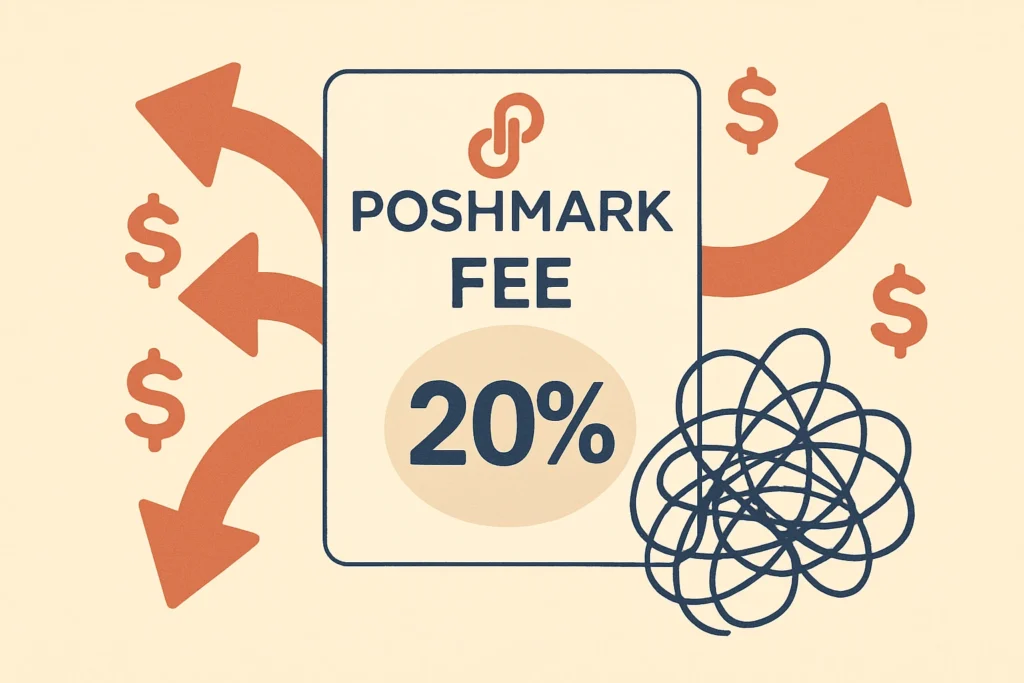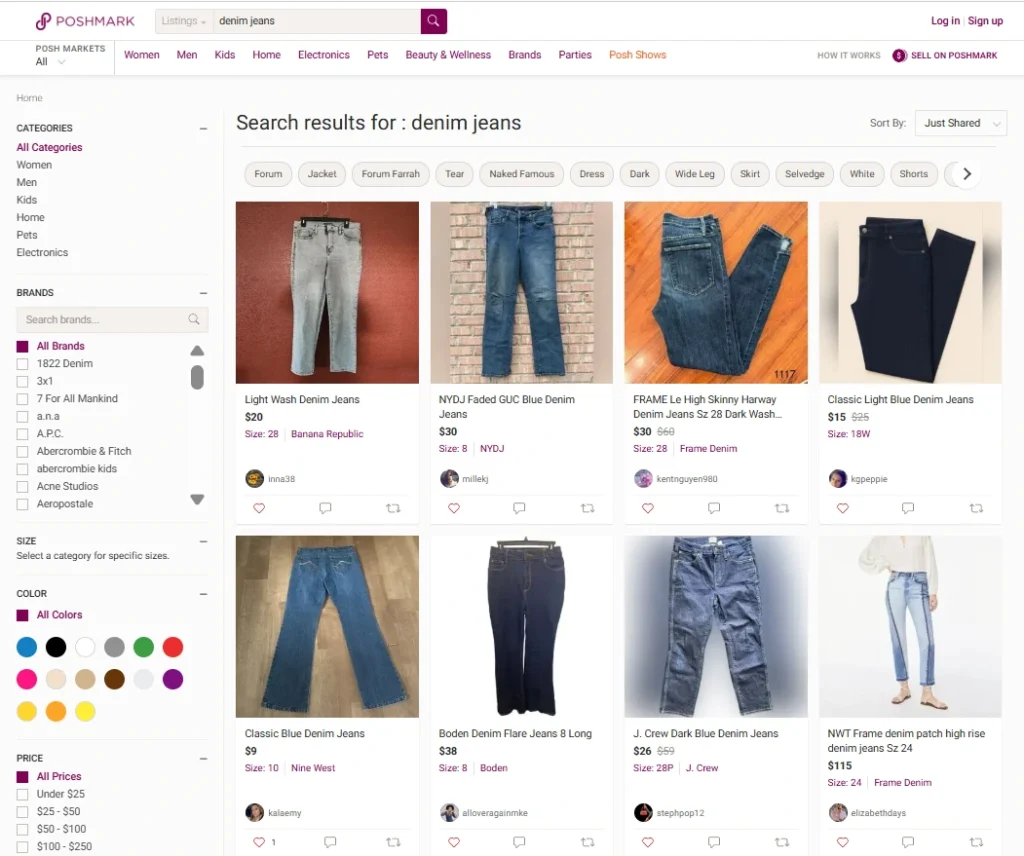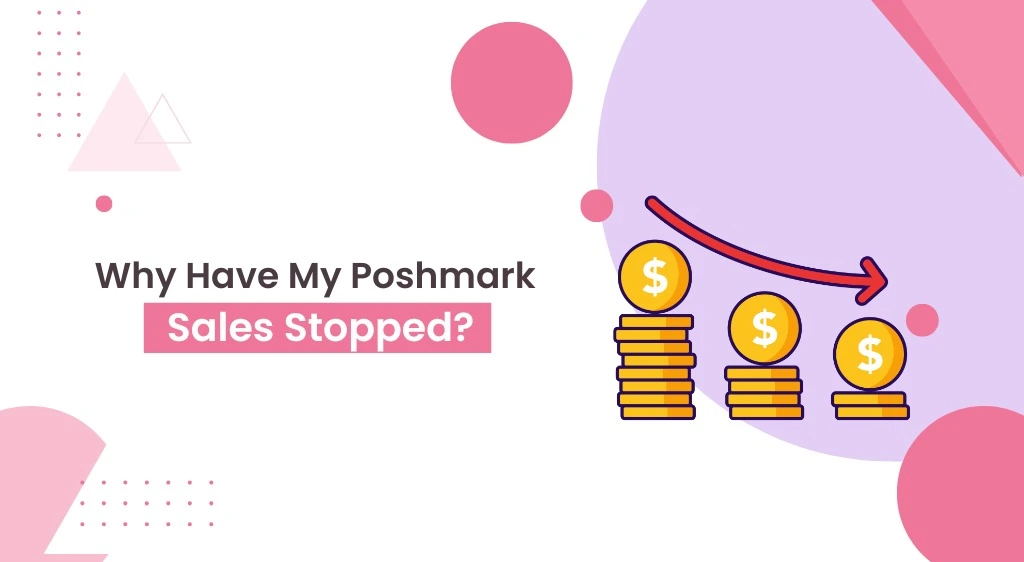Watching your Poshmark sales suddenly drop can be a punch to the gut. One day, your closet is buzzing with offers, the next, crickets!
It’s not always about the items you’re selling on Poshmark. Shifts in buyer trends, algorithm changes, or even small mistakes in your listings can quietly tank your visibility.
Competition is fierce on Poshmark, and getting consistent sales requires more than just listing items.
In this blog, we’ll dig into the real reasons your Poshmark sales have stopped and share practical strategies to get your listings moving again.
7 Reasons Why Your Poshmark Sales Stopped
1- Economic Slowdown

One major reason why you’re noticing a drop in your Poshmark sales is the global economic slowdown that’s affecting consumer behavior.
Global trade tensions, including President Trump’s trade policies and tariffs, have contributed to a slower flow of inventory and rising costs for consumers in the US.
As a result, buyers are more cautious with discretionary spending, including fashion and luxury items. Most product categories, from clothing to fashion accessories, are experiencing noticeable declines in demand.
Economic forecasts also reflect this trend. Goldman Sachs predicts only about 1% growth in the final two quarters of 2025 due to slower consumer spending, weaker job growth, and stagnating real income increases.
For resellers, this means fewer buyers actively scrolling and purchasing on marketplaces like Poshmark.
While your listings are visible on Poshmark, the pool of buyers ready to spend is shrinking.
2- Poshmark Fee Structure Chaos

Another factor that disrupted Poshmark’s sales this year is the fee structure drama last year, which created confusion among both sellers and buyers.
Poshmark’s selling fee structure used to be very simple. All items under $15 have a flat $2.95 fee, while items that are priced higher than $15 have a 20% commission fee.
In October 2024, Poshmark introduced a new 1-2-3 fee structure: a small fixed fee plus 5.99% of the total order value, which included shipping and taxes.
Moreover, they added a buyer protection fee, meaning buyers had to pay extra. For many orders, this made total fees higher and harder to understand. The result was buyer frustration and slower sales.
After significant backlash for both buyers and sellers, Poshmark reverted to the original fee structure on October 21, 2024.
While Poshmark offered rebates to some sellers, the fee confusion caused lasting disruption. Buyers felt uncertain about pricing while sellers felt uncertain about their earnings and profits, leading to a slowdown in sales.
3- Changes in Poshmark Algorithm

Poshmark’s algorithm changes can be another reason why you stop getting sales, though the platform keeps its inner workings confidential.
Fundamentally, Poshmark’s algorithm prioritizes listings and sellers that drive the most engagement and sales.
Key factors include listing freshness, keyword accuracy, and consistent seller activity, all of which influence how often items appear in Poshmark feeds and search results.
Sellers who previously relied on consistent traffic may notice sudden drops if their listings no longer align with algorithmic priorities.
Even small changes in the algorithm can dramatically affect visibility, making it harder for both old and new sellers to maintain sales momentum.
In addition, algorithm tweaks often favor trending categories, popular brands, or seasonal items, meaning if you’re selling anything outside these niches, you may experience slower sales.
4- Not Keeping Up with Seasonal Demands

Another reason why your Poshmark sales are dropping is failing to list items that align with seasonal demand.
Buyers on Poshmark, who are mostly women, naturally shop for summer dresses in June, cozy outerwear in November, and winter coats in December.
So if you have listed out-of-season items on Poshmark, your closet is definitely going to get overlooked.
Poshmark’s algorithm also prioritizes listings that match what buyers are actively looking for.
Items that don’t fit the season receive lower or no visibility, appearing further down search results and feeds. This reduces likes, shares, and offers, which slows sales momentum.
Competition further intensifies the issue. Seasonal items dominate searches, so off-season stock competes with current, trending products, making it harder to attract buyers.
Stagnant, irrelevant inventory also ties up capital, leaving less room to refresh your Poshmark closet with high-demand items.
So, stay in sync with seasonal trends to ensure your listings are more discoverable and you’ve increased buyer engagement with consistent sales throughout the year.
5- Not Being Consistent with Sharing

Sharing consistently matters a lot on Poshmark, and it also might be one of the major reasons why you’re struggling to get sales on Poshmark.
Poshmark’s algorithm favors listings that are frequently shared, so items you neglect to share regularly sink in search results and feeds, making them less visible to poshers.
Frequent sharing on Poshmark signals activity, encouraging more engagement. If your sharing is inconsistent, your closet appears dormant, which can discourage shoppers from browsing or making offers.
Timing also matters a lot. Buyers on Poshmark are active at different hours, and inconsistent sharing may cause your listings to miss peak traffic, resulting in lost opportunities.
Poshmark rewards active sellers with higher placement in search results, so not sharing listings at all or being inconsistent with sharing is indirectly letting you down.
You can use Sidekick Tools’ Poshmark sharing tool to solve this problem by automating all sorts of sharing, be it self-sharing, community sharing, Posh Parties sharing, or sharebacks. Not only it’s fast, but it also keeps your Poshmark closet active like a human would.
6- You’ve Stagnant Listings in Your Closet

Stagnant listings are a silent killer of Poshmark sales. Items that haven’t been relisted for weeks or months gradually drop in search results, reducing exposure to poshers.
Without fresh activity, listings lose placement in the “Just In” feed, which is where active Poshmark shoppers focus their attention.
The Poshmark algorithm favors sellers who consistently update, share, and relist items. Dormant listings are deprioritized, meaning even well-priced or SEO-optimized listings sit unsold.
Buyers on Poshmark usually scroll past older listings, assuming they’re no longer available, which compounds the issue.
If you don’t have time to relist dozens of items in your Poshmark closet, then you can use the relisting tool by Sidekick Tools that enables sellers like you to relist hundreds of items in seconds.
7- Oversaturation of Sellers

Poshmark is a bustling marketplace, but it’s now oversaturated with sellers, which is stifling sales.
With thousands of sellers listing similar items daily, many listings get buried. Shoppers see new arrivals first, leaving older items overlooked.
High competition also impacts buyer behavior. When many sellers offer the same product, price wars emerge, urgency decreases, and even the best listings sometimes struggle to convert.
Limited buyer attention further exacerbates the problem, as shoppers scroll past multiple listings or leave searches unfinished.
That’s why standing out organically becomes increasingly difficult without consistent promotion.
But! You can try Sidekick Tools’ Promoted Listing Service, which is an advertising network of thousands of closets with genuine followers.
With the Promoted Listing Service by Sidekick Tools, your items receive community shares and broader exposure, reaching millions of active Poshers.
This not only boosts visibility but also dramatically increases impressions, engagement, and the likelihood of consistent sales, even in an oversaturated marketplace.









